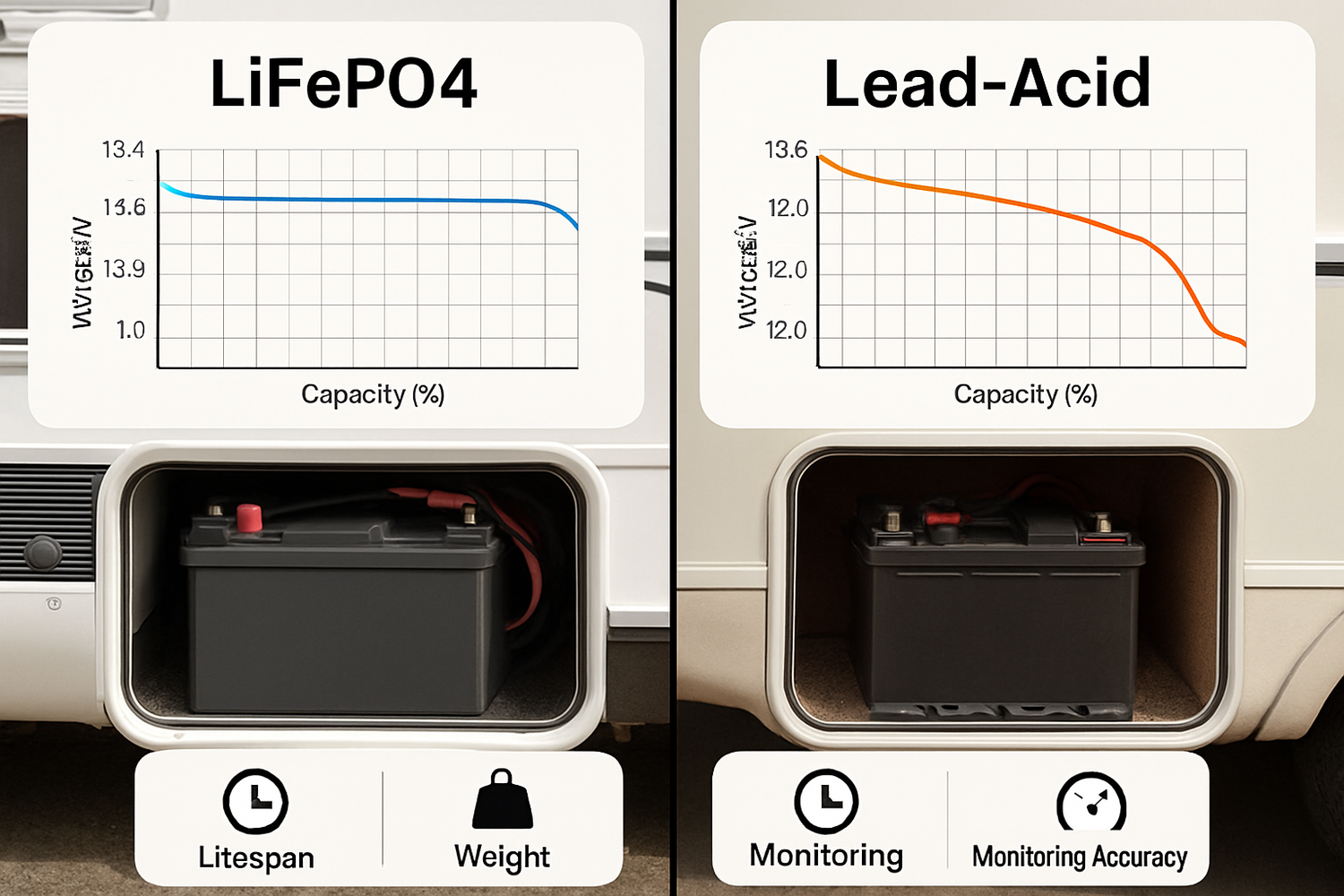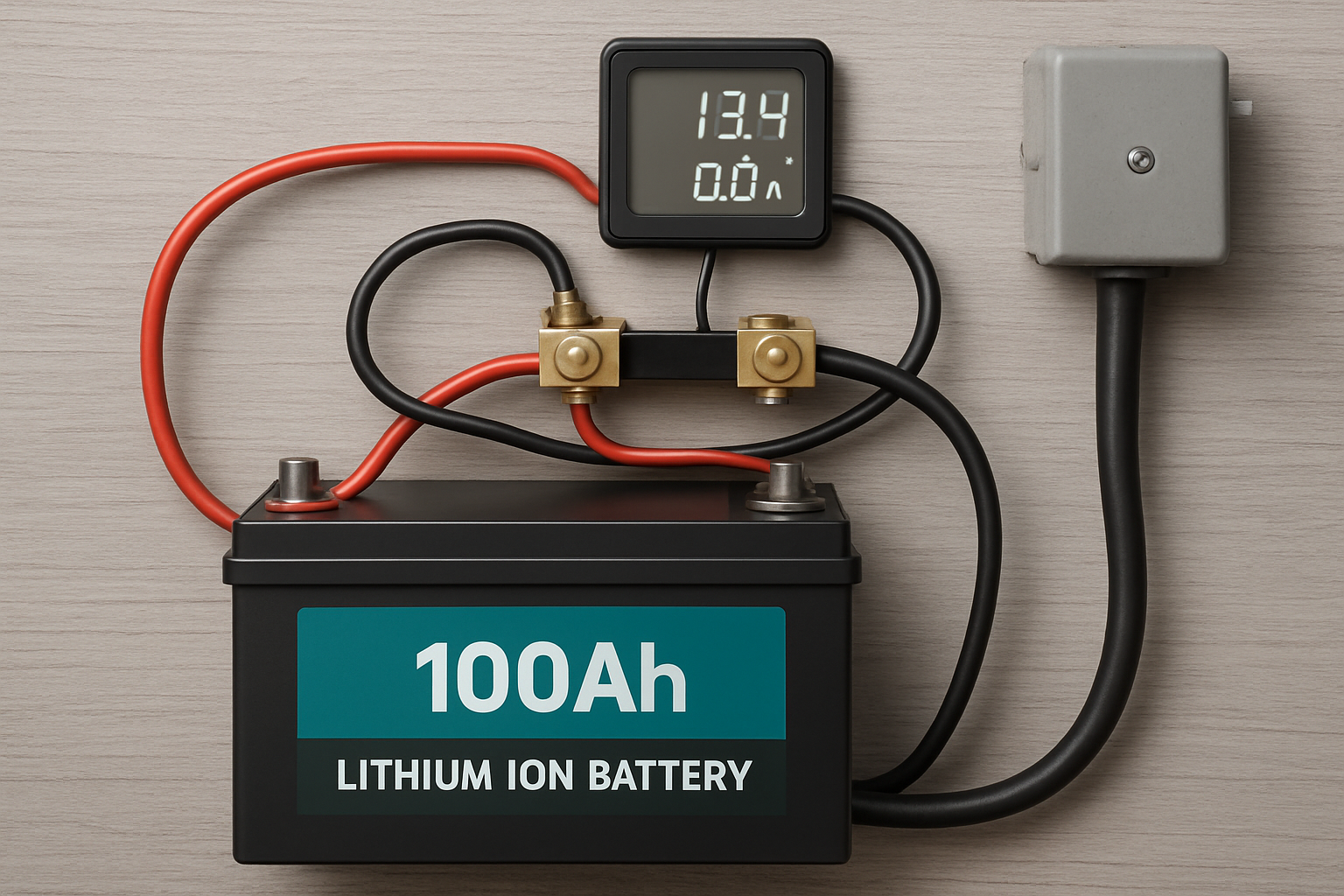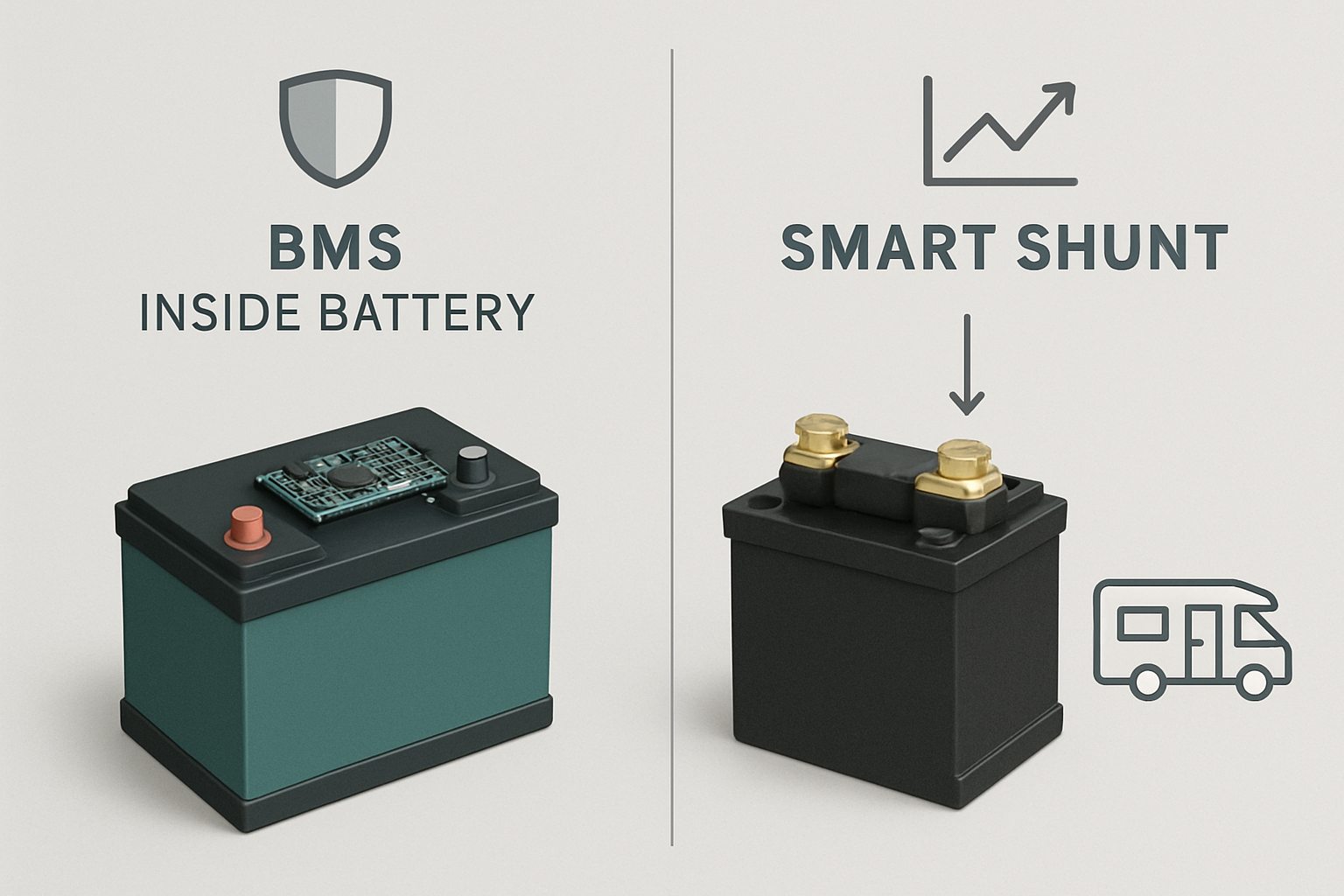A reliable power system is the heart of any recreational vehicle, enabling everything from lights and refrigeration to navigation and entertainment. At the center of this system is the battery. While both traditional lead-acid and modern lithium iron phosphate (LiFePO4) batteries can power your adventures, how you track their energy levels is fundamentally different. Relying on old methods with new technology can leave you unexpectedly in the dark. Understanding these distinctions is key to achieving true energy independence on the road.
The Core Chemistry: Voltage Curves Tell the Story
The primary reason for the difference in monitoring lies in the unique chemical properties of each battery type. How a battery's voltage behaves as it discharges is the most critical factor. This behavior, known as the discharge curve, dictates the right tools for the job.
The Flat Discharge Curve of LiFePO4
A 12V LiFePO4 battery exhibits a remarkably flat discharge curve. It delivers a consistent voltage—typically between 13.2V and 12.9V—for up to 90% of its discharge cycle. This stability is excellent for your RV's appliances, as they receive steady power without performance dips. However, it makes voltage an unreliable indicator of the battery's remaining capacity. A small, almost imperceptible drop in voltage could signify a massive change in the actual energy left. This high energy density is a significant advantage of lithium-ion technologies. According to research from the IEA, lithium-ion batteries offer an energy density of 90–260 Wh/kg, far surpassing the 35 to 40 Wh/kg of lead-acid batteries, making them lighter and more compact. *This data comes from the IEA's report, The Role of Critical Minerals in Clean Energy Transitions.*
The Steep Decline of Lead-Acid Voltage
In contrast, a lead-acid battery's voltage drops in a predictable, linear fashion as it discharges. A fully charged 12V lead-acid battery might read around 12.7V, dropping to 12.2V at 50% capacity, and falling to 11.8V or lower when nearly empty. This direct correlation makes a simple voltmeter a reasonably effective tool for estimating its state of charge (SoC). While not perfectly precise, it provides a functional gauge of how much power is left.
Why Traditional Monitoring Fails with LiFePO4 Batteries
Using a monitoring method designed for lead-acid on a LiFePO4 battery is like using a car's fuel gauge that reads 'full' until the moment it runs out of gas. It creates a false sense of security and makes effective power management nearly impossible.
The Guessing Game with Voltage Meters
For a LiFePO4 battery, the voltage might only change by a few tenths of a volt between being 90% full and 20% full. Environmental factors like temperature can cause similar voltage fluctuations, making it impossible to distinguish between a full battery and one that is nearing depletion based on voltage alone. This lack of clarity undermines the reliability that is a primary reason for upgrading to a lithium battery system.
The Peukert Effect: A Lead-Acid Complication
Lead-acid batteries also suffer from a phenomenon known as the Peukert effect. This means that the battery's available capacity decreases as the rate of discharge increases. If you run a high-power appliance like a microwave, you get less total energy from a lead-acid battery than if you only run low-power lights. LiFePO4 batteries are not significantly affected by this, delivering their full rated capacity regardless of the load. This consistency simplifies power calculations but further highlights why a different monitoring approach is necessary.
Modern Solutions for Reliable Power Management
To accurately monitor a LiFePO4 battery bank, you need tools that measure energy, not just voltage. Modern RV energy systems rely on more sophisticated devices to provide a true picture of your power reserves.
Shunt-Based Battery Monitors: The Gold Standard
The most accurate way to monitor any battery, especially LiFePO4, is with a shunt-based battery monitor. A shunt is a device installed on the negative battery cable that precisely measures every amp-hour of current flowing into and out of your battery. This process, often called 'coulomb counting', acts like a real-time energy accountant. It gives you a precise percentage-based State of Charge (SoC) reading, along with other vital data like current power consumption and time remaining. This is the only way to know with certainty that you have 75% power left, not just 'around 13 volts'.
The Role of the Battery Management System (BMS)
Every LiFePO4 battery pack includes a Battery Management System (BMS). The BMS is an electronic circuit board that protects the battery from operational hazards like over-charging, over-discharging, extreme temperatures, and short circuits. It also ensures all the individual cells within the battery are balanced, which is crucial for longevity and performance. While some advanced BMS units can communicate SoC data, their primary function is protection. A dedicated, user-facing shunt monitor is the standard tool for tracking day-to-day energy usage in an RV.
Practical Implications for RV Owners
Choosing the right monitoring system directly impacts your travel experience, your budget, and your peace of mind. The goal of any RV power system is reliability, and accurate monitoring is the only way to achieve it. As noted by IRENA, electricity storage is a prominent solution for ensuring a reliable and cost-effective power system. *This insight is from the Electricity Storage Valuation Framework.*
Energy Independence and Peace of Mind
With an accurate SoC reading from a shunt monitor, you can confidently manage your energy usage. You know exactly how much power your solar panels are producing and how much your appliances are consuming. This allows you to make informed decisions, such as when to conserve energy or when it's okay to run a high-draw appliance, enabling true off-grid freedom without the constant worry of running out of power.
Protecting Your Investment
Both lead-acid and LiFePO4 batteries represent a significant investment. Proper monitoring helps protect it. For lead-acid, it prevents deep discharges below 50% capacity, which can cause permanent damage. For LiFePO4, it ensures the battery operates within its optimal parameters, maximizing its already long lifespan. Understanding how to manage your power system is a key part of its long-term health. You can find more details in this Ultimate Reference for Solar Storage Performance, which covers how different factors contribute to system longevity.
| Feature | Lead-Acid Battery | LiFePO4 Battery |
|---|---|---|
| Monitoring Method | Voltage Reading (Moderately Accurate) | Shunt-Based Monitor (Highly Accurate) |
| Voltage Curve | Steep, predictable decline | Flat, stable |
| Capacity & Load | Affected by Peukert's Law | Consistent capacity under load |
| Primary Monitor Tool | Voltmeter | Shunt / Coulomb Counter |
| Consequence of Inaccuracy | Risk of unexpected shutdown, battery damage | Inability to know true remaining power |
Making an Informed Choice for Your RV
Upgrading your RV's energy system is about more than just swapping out a battery. It requires a shift in how you measure and manage your power. The superior performance of a deep cycle lithium battery is undeniable, but its benefits are only fully realized with an appropriate monitoring system. While a voltmeter is adequate for the declining voltage of a lead-acid battery, the stable chemistry of LiFePO4 demands the precision of a shunt-based monitor. By pairing your advanced battery with the right tools, you ensure a safe, reliable, and stress-free power supply for all your adventures.
Frequently Asked Questions
Can I use a standard voltmeter for my LiFePO4 RV battery?
You can, but it will not provide a useful State of Charge reading. Due to the flat voltage curve of LiFePO4 chemistry, the voltage stays nearly constant from 90% down to 20% charge. A voltmeter cannot distinguish between these levels, making it an unreliable tool for power management.
What is a battery shunt and why do I need one?
A battery shunt is a device that measures the actual current (in amps) flowing in and out of your battery. By tracking this flow over time (a method called coulomb counting), it calculates a highly accurate percentage-based State of Charge (SoC). It is the most reliable way to know exactly how much energy is left in your LiFePO4 battery.
Does the BMS in my LiFePO4 battery tell me the State of Charge?
The primary role of a Battery Management System (BMS) is to protect the battery cells from damage. While some sophisticated BMS units can estimate and communicate SoC, a dedicated shunt-based monitor provides a more accurate reading and a user-friendly display with more detailed information for managing your entire RV energy system.
Is monitoring a lead-acid battery with a shunt more accurate?
Yes. Although a voltmeter provides a decent estimate for lead-acid batteries, a shunt monitor is still far more accurate. It accounts for all energy moving in and out, providing a true SoC reading that is not affected by load size (the Peukert effect) or temperature, giving you a much clearer picture of your available power.





Leave a comment
All comments are moderated before being published.
This site is protected by hCaptcha and the hCaptcha Privacy Policy and Terms of Service apply.